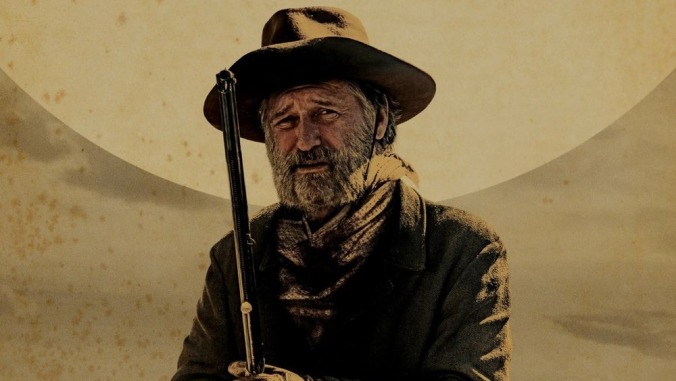Montana, 1889. A dying man staggers out of a saloon and keels into the rainy mud. Into frame step two figures in long coats, the famed gunfighter Edward Johnson (Peter Fonda) and his trusty sidekick Lefty Brown (Bill Pullman), both sixty-seventy-something and gray-haired. They catch the man’s killer out behind the saloon and hang him from a gnarled tree at dawn, just like in their glory days—one last act of frontier justice before Johnson packs up for Washington as a senator for their newly ratified and civilizing state. He has become a respectable man, but still loves Lefty as his closest friend, even if nobody else sees much worth in the old coot. But days later, as the two are chasing off some cattle rustlers, an outlaw lands a shot right into Johnson’s skull. Suddenly, the Old West legend is gone. What’s a sidekick to do?
Intriguing but ultimately prosaic, the low-budget Western The Ballad Of Lefty Brown is bluntly about the aftermath of the mythic West. The title character—modeled on the kind of comic-relief sidekicks played by Gabby Hayes and Dub Taylor in dozens of third-rate oaters in ’30s and ’40s and by Walter Brennan in Rio Bravo and Red River—isn’t the only one who’s been left behind. (Get it?) Johnson left no written will, and without it, his widow (Kathy Baker) stands to lose their cattle ranch to the closest male relative the law can find. And there’s the matter of Jeremiah (Diego Josef), the teenage boy who joins Lefty in the search for his best friend’s killer. He’s a wannabe gunslinger with a headful of dime novels, many of them fancifully adapted from Lefty and Johnson’s own adventures decades ago.
Writer-director Jared Moshé, who made his debut with the throwback Western programmer Dead Man’s Burden, juggles a lot of ideas about the mythology and gentrification of the frontier, though none of them are fresh; at this point, Westerns have been commenting on their own tropes for something like 70 years. His acknowledgements of the messiness and horror of the Old West are curt: a bullet dug out with dirty fingertips here, a wound cauterized with a heated shotgun barrel here. Despite the novel twist of making a stock supporting character like Lefty the unlikely focus of the story, Lefty Brown’s ambitions remain as modest and muddled as its dirty earth-tone color palette. Pullman’s quirky but restrained performance does most of the work of sustaining viewer interest; it finds glimmers of psychology behind the whistle-y voice, unkempt beard, and upturned hat.
One might pin the blame on the film’s modest means; it was reportedly shot in 20 days, mostly in a state park. But then, the cheapie oaters of decades past made do with even less. (The great Samuel Fuller filmed his Western-mythology-questioning debut, I Shot Jesse James, in only 10 days.) Moshé’s camera style errs on the side of network-TV pragmatism, and despite the wide-open scenery, his staging tends to be uninventive and ragged. The last few years have seen a wide-ranging revival of the Western, whether in wordy mutations like Bone Tomahawk and The Hateful Eight, conscious B-pictures like The Salvation, or Western-in-theme-only items like Logan. But few of these latter-day oaters have aspired to do so little with style. The Ballad Of Lefty Brown’s lack of flash keeps it from sinking comfortably into pastiche, but it doesn’t make for thrilling viewing.

